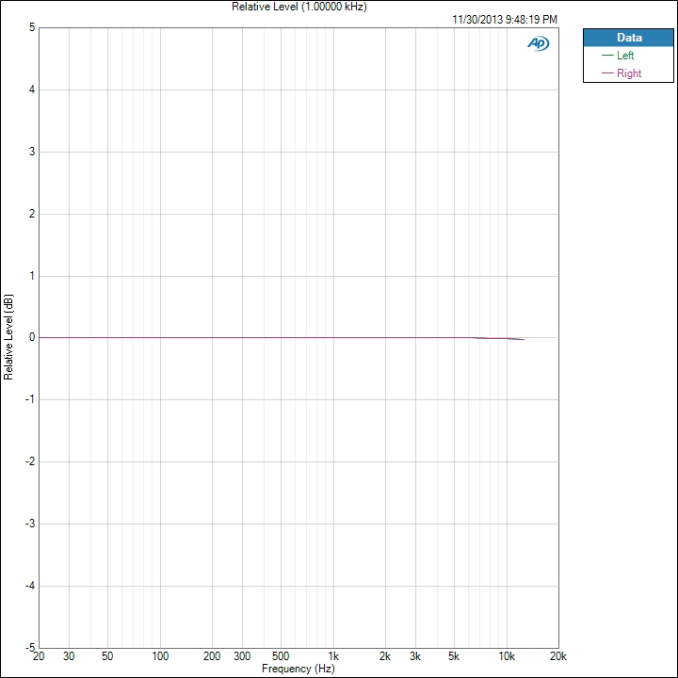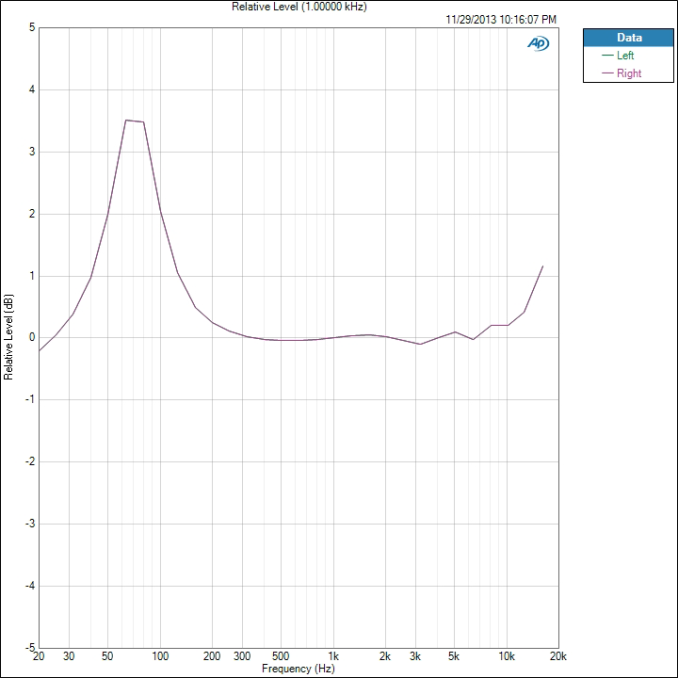Smartphone Audio Quality Testing
by Chris Heinonen on December 8, 2013 5:15 PM EST- Posted in
- Smartphones
- Audio
- Mobile
- Tablets
- Testing
Maximum Level
The maximum output level is derived from the 1kHz test tone used to determine THD+N. The higher the output from the headphone jack, the louder it can drive a pair of headphones. More importantly, having more power available means when you have dynamic music passages that call for power you are less likely to clip the waveform.
There is no chart to show here, just a number that the Audio Precision gives us. In our test data, the most powerful phone was the iPhone 5, at 32.46 mW of power. Next is the Nexus 5 at 22.24 mW, though we can’t drive it that high. Then the Note 3 at 11.81 mW and finally the Galaxy S4 at 3.895 mW. Doubling the power, from 4 mW to 8 mW, produces a 3 dB increase in volume level. 3 dB is the smallest change in volume levels we can easily hear. So even though the iPhone 5 produces 32 mW vs. 4 mW, that is only a 9 dB difference in volume. 10 dB is doubling the volume, so it isn’t even twice as loud. If you have demanding headphones, you will want as much power as you can get.
Frequency Response
To measure the frequency response we measure a set of 61 tones from 20 Hz to 20 kHz. All of these are then equalized to 1 kHz so we can see the maximum deviation from that level. An ideal phone will be perfectly flat here and allow you to adjust this with an EQ setting, or though your taste in headphones. On this test our best performing phone is the Galaxy S4, as seen here.
The total variation from 1 kHz is only 0.014 dB which is very good. The worst performing phone is the iPhone 5, but its variation is only 0.089 dB.
The iPhone 5 also picked up the 20 kHz tone while the Samsung and many others missed it. If we dropped this tone then it might be just as flat. The iPhone 5 test was run slightly differently, as it can't run the Android test program, which might account for this. For a phone with a different response, here is the HTC One with Beats enabled. Other HTC One testing is still in progress as I write this article.
Here we see that Beats is adding a +3.5 dB boost from 60 Hz to 90 Hz, but the deviation from 0 dB goes from 30Hz to 300 Hz. Past 6.5 kHz we also see a rise in the treble. People often mistake boosted treble for extra detail, which is likely the reasoning behind this. As we see it is far different than the other two examples we looked at.













188 Comments
View All Comments
Friendly0Fire - Sunday, December 8, 2013 - link
The Nexus S has some of the best DAC in the industry, actually... Most phones these days use the built-in Snapdragon DAC, but the S has a Wolfson DAC which is way superior.I think you either had a dud or you have another issue somewhere because the S was lauded for sound quality (just like the original Galaxy S).
tedders - Sunday, December 8, 2013 - link
I must have had a dud Galaxy S then too because my Captivate had abysmal audio.Samus - Monday, December 9, 2013 - link
The captivate and epic 4G (sprint variant) were substantially different from the galaxy s, although I remember the epic 4G touch (S2) having decent audio quality.tipoo - Sunday, December 8, 2013 - link
So I've heard, but I'm not the only one with shit audio on it, the running theory is they put in a good DAC but didn't bother properly making drivers or something for it.tipoo - Sunday, December 8, 2013 - link
Or perhaps improper shielding of the audio circuit from the radios, since the static seemed to be radio related. Even modern phones have some of that, even the best sounding ones like the iPhone 5S, but it's much much reduced.cheinonen - Sunday, December 8, 2013 - link
The DAC really means nothing without knowing everything else that goes into the circuit. Yes, the DAC might have superior SNR and THD+N but if you use an amplifier, or a volume control circuit, that are worse than other phones, you've now mitigated that advantage. It's there in the DAC but by the time it gets to the output stage it's been buried by noise elsewhere in the system.Using a better DAC is nice. But you can't just drop it in and get better results, everything else needs to be engineered around it as well.
Friendly0Fire - Sunday, December 8, 2013 - link
Using a higher end separate DAC hints that the manufacturer at least somewhat cares about sound quality. Using the built-in SoC DAC says that it's an afterthought.It's not a guarantee, but it's certainly an indicator.
Galidou - Sunday, December 8, 2013 - link
Totally agree with cheinonen, any high end audio stereo setup is as strong as it's weakest link. Take the excellent nuforce DAC-100 at ~1200$CAD, use it with a poor sub 400$ multi channel receiver and you won't get much out of it. The nuforce got plenty of amazing review, but it always depends on what it is paired with.The galaxy sure got a nice DAC but it's amplifier section is poorly engineered.
cjl - Monday, December 9, 2013 - link
Actually (and I know audiophiles everywhere will disagree with me on this, but whatever...), you can get audibly perfect sound with a dac worth only a couple hundred dollars at most, and an amp of similar cost. There's really no point in buying a >$1k dac, and the same goes for an amplifier (though expensive multi channel receivers can be justified, not for the quality of their amplifiers, but for the quality of their DSP, room correction, video upscaling, and variety of inputs and outputs). For an audio system, by far the most important component is the speakers. You should spend the vast majority of your audio budget on the transducers (speakers/headphones), then buy an amp with sufficient power to drive them to whatever level you need without distortion/clipping (which is almost always less power than recommended by audiophiles). The rest of the system can really be quite inexpensive - the built in DAC in most modern audio products is audibly flawless, and it's impossible to improve on 14AWG zip cord for the cables (from an audibility standpoint) unless you're running your wires over an extremely long distance.Now, that isn't to say that modern smartphones have reached that audibly flawless point yet - many of them haven't (especially when they have such blatant flaws as the single channel clipping shown in the review above), but many of them are a lot closer than people realize, and it really doesn't cost much to make a product audibly flawless. I remember seeing testing done on the latest iPod, and it was good enough to not contain any audible flaws. I would assume that the iPhone is similar, and the GS4 looks to also be audibly perfect in the review above (so long as 500mV p-p is sufficient to drive your headphones - this may not be the case for some less sensitive models).
speculatrix - Tuesday, December 10, 2013 - link
+1A lot of audiophile ideas simply don't stand up to basic engineering principles, and blind A:B tests show it.